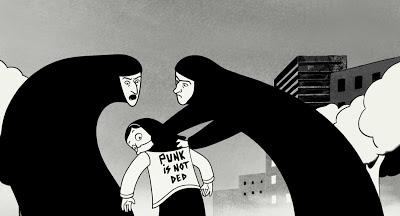Format: DVD from DeKalb Public Library on rockin’ flatscreen.

Persepolis is a film that I’ve been looking forward to since I added Best Animated Feature as a category on this site. It’s also one that I’ve more or less been holding back on to give me something to continue to look forward to. I’ve set getting through all of the remaining Best Animated Feature films by the end of this year as a goal, though, so it was time to watch this. The real question with Persepolis isn’t whether or not it’s any good, though, but whether or not it lives up to the hype.
Fortunately, it does. The disc I got came with both French and English versions, and I watched the English, which I tend to do with foreign animation. There’s no real reason for it beyond the fact that animated films are dubbed by definition. Here, since two of the main characters are voiced by the same actresses in both French and English, it mattered even less.
Persepolis is the story of Marjane Satrapi (voiced by Chiara Mastroianni), an Iranian woman who grew up during the revolution and the aftermath. Marjane is depicted in the film as being descended from a family with a history of fighting for freedoms. This naturally comes into play in the opening as the Iranian people struggle against the government of the Shah. Of course, once the Shah is deposed, the theocratic crackdown on society is far more severe than anything imposed on the people before. This is particularly true of the treatment of women, and this is particularly difficult for an independent and headstrong young woman like Marjane.
Since Persepolis is autobiographical, everything comes from the point of view of Marjane. Like many an autobiography, this is very much the story of a search for self. When the theocratic state takes power, Marjane’s reaction is to rebel, which is potentially very dangerous in a closed culture like Iran became. After causing too much trouble in school, her parents (Catherine Deneuve in both versions and Sean Penn in the English) send her away to a French school in Vienna, where Marjane’s real quest for her own identity begins. Cut off from family at a young age, tossed into a very different and Western culture and forced to live with nuns, Marjane quickly loses not only that which makes her Iranian, but that which makes her Marjane Satrapi.
Much of this loss of identity comes from Marjane’s doing all she can to deny her Iranian heritage on the assumption that it would make her even more of an outcast. In this respect, while the story is Marjane’s life, the emotional center of the film is her beloved grandmother (Gena Rowlands in the English version). It is the grandmother who keeps Marjane centered in who she is, who reminds her not to deny her past or her family’s history.
While there are moments of comedy here, this is not a comedy film. Instead, it feels very much like a story of almost overwhelming oppression. Marjane’s story continues through feeling disconnected from the bourgeoisie classmates in Vienna, cheating boyfriends, homelessness, sickness, and depression. It follows her return to Iran, a suicide attempt, a failed marriage, and eventually a self-imposed exile from the country. And yet throughout all of this, the enduring message is one of hope and triumph. For a film with this many low points and dark moments, it is ultimately something of a triumph at the end.
Of course, with animated films, much of the value comes specifically in the artwork. There are plenty of animated films that might not be much in the story department but are worth watching because of the beauty of what is on screen; a film like The Adventures of Prince Achmed comes to mind immediately. Persepolis is definitely old school when it comes to the artwork. This was, I can only imagine, a careful choice made to keep as much of the feel of the original graphic novel as possible. The film has a definite two-dimensional quality in the art that works very well for it. Additionally, it demonstrates three specific time periods very clearly. The autobiographical past, the bulk of the narrative, is in black-and-white. Present day is in full color. The few moments near the start that recount Iranian history are black-and-white, but are animated more in the style of a shadow puppet show.
I can certainly see someone being underwhelmed by the often simplistic artwork here. In truth, the art does come across as merely functional at times, but it’s not the art that’s the sell. It’s the story that is the main draw for Persepolis. Additionally, the art is actually surprisingly detailed and quite beautiful. Its evident simplicity is smokescreen; there’s a lot going on here, and like any good art in an animated film, it enhances the story rather than simply accompanying it.
It’s also worth noting the decision to keep this mainly in black-and-white. First, this serves as a nod to the graphic novel on which the film is based. Second, rather than putting up an additional wall between the audience and the characters, it enhances the humanity of these people. It would be easy, with this filmed in color, to see Marjane and her family as “other” rather than what they are: people trying to get through life in a difficult situation as best they can.
Hell of a good film. It’s not for the kids, but it’s worth an evening’s viewing and a talk over coffee afterwards.
Why to watch Persepolis: More evidence that animation isn’t always for kids.
Why not to watch: If you disagree with the previous sentence, you’ll be unprepared.
